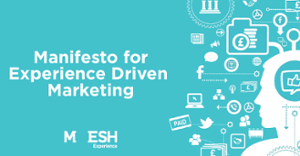Over the years, questions have increasingly been raised about the viability and ROI of traditional brand health tracking. Brands are asking whether it is cost effective, in relation to the business decisions delivered. They are craving a more forward-looking, predictive approach to metrics. They are wondering whether in fact they would be better off listing to the signals from social and behavioural data, rather than asking the same old questions and getting the same old answers.
And there is more. Some of the longstanding accepted measures such as brand consideration feel blunt these days. Metrics don’t move much – and when they do, there is panic or celebration, but little in the way of real results. Maybe that’s a simple function of the increasingly complex interaction between paid, owned, and earned brand touchpoints, and the inability of standard rear-view mirror methods to get to grips with the reality of context. Marketers need to look beyond the traditional metrics of share and reach and consider measuring such things as impact, relevance and positivity, since the quality of touchpoints can turbo-charge your media strategy.
We’ve given all this much thought. That’s why at MESH we’ve focused on what we call Experience-Driven Marketing, and built the capability to track the experiences people have with brands in real time. Categories like peer observation (seeing someone else using your brand) and retailer advertising (seeing your brand featured in a retailer ad) can significantly impact on brand consideration.
Note: this is not the same as experiential marketing. What we are saying is that rather than looking through the traditional lens of getting a read on what marketers push out, we need to be permanently attuned to what people are experiencing in their everyday lives. In a social and mobile world, brands don’t control the conversation. So we think it is important to be able to read the full range of experiences, to set a brand’s paid campaign activity in context with (a) what the competition is doing at the same time, and (b) owned brand assets and earned experiences, including WOM, news, social, and so on. That gives clients some important new metrics, such as Share of Experience (SOE), along with Share of Positive Experience as a subset. As you may imagine, these things tend to correlate far more effectively with share of market and brand consideration than ‘push’ metrics like share of voice. Paid media is often the starting point to generate owned and earned touchpoints, which are increasingly digital. Paid tweets, for example, can be very positively received when well targeted.
To get to this, we are mindful of three main principles:
- Immediacy. We need to get people to record their experiences there and then, not through flawed recollection.
- Mobile first. That’s the only way to pick up this information, and it’s what participants expect.
- Simplicity and depth combined. It shouldn’t take more than a minute to record an experience – a few simple ratings for positivity, and an open ended ‘in your own words’ description of the experience and how it made people feel.
It is also fair to say that these principles reflect a need to address the main areas where, from the participant point of view, traditional brand tracking questionnaires can fail to engage with modern behaviours.
We also believe the future of brand tracking is about integration. The RET approach delivers single-source context, but wherever possible we look to bring in passive data too. That could be social media chatter, listening apps that capture what people are watching on TV or seeing on the internet, or it could be the more tangible physical context. For example, we are piloting what we call Real-time Retail. This involves using tech (e.g. passive facial recognition technology that picks up data points, not video, so avoid any privacy issues) to track what’s going on in a physical environment like a store, a bank branch and so on. We can analyse traffic, demographics, even the emotions people seem to exhibit. All that can really help us see how well (e.g.) point of purchase material is working.
So there are many angles to Real-time Experience Tracking. Clients often describe their experience databases as goldmines. Each individual experience provides its own insight; in aggregate, they tell the full story of a brand.
After all, people now build their pictures of brands from direct experience, not just from adverts, and we can use advanced analytics to unpick exactly what experiences make a difference. Clients can (and do) use this data – their marketplace seen through the customer’s eyes - to decide important questions about campaign spend and touchpoint effectiveness.
And now, with 10 years’ worth of data across a range of sectors, we can benchmark all this. We know exactly what good and bad experiences look like, and we know how they can affect a brand.
So in sum, MESH believes the future of brand tracking is about (a) better representing the reality of the customer’s world; (b) moving away from abstract retrospection; and (c) embracing more holistic ways of gaining in-the-moment human insight.
We are already seeing many clients moving in this direction, and we hope for many more!
Download MESH Experience's Manifesto for Experience Driven Marketing
and learn how this new framework can fuel your brand growth!
Download the full presentation for free!
Contributor:
Andy Dexter, Senior Consultant

